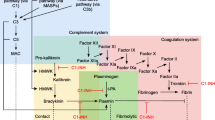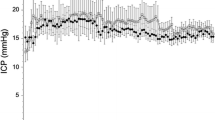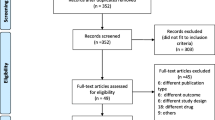Summary
We performed a randomised prospective double blind trial to study the effect of the calcium antagonist nimodipine on the outcome of head injured patients. The subjects were not obeying commands at the time of entry to the study, within 24 hours of injury. One hundred and seventy-five patients received nimodipine IV, 2 mg per hour for up to 7 days and 176 received placebo. The two groups were well matched for important prognostic features. Six months after injury 93 (53%) of the nimodipine group and 86 (49%) of the control group had a favourable outcome (moderate/good recovery). The relative increase in favourable outcomes (8%) was not significant but is compatible (95% C.I.) with an increase in favourable outcomes in treated patients by 33% or a decrease by 12%. Nimodipine was well tolerated and there were few adverse reactions; means of systolic and diastolic blood pressures and the intracranial pressure did not differ between the groups. It is unlikely that nimodipine has a marked effect on outcome (ie an increase in favourable outcome of >15%) after head injury of this severity but the study does not exclude a modest but clinically useful benefit.
Similar content being viewed by others
References
Andrews PJO, Piper IR, Dearden NM,et al (1990) Secondary insults during intra-hospital transport of head injured patients. Lancet 335: 327–30
Becker DP, Miller JD, Ward JD (1977) The outcome from severe head injury with early diagnosis and intensive management. J Neurosurg 47: 491–502
Berger L, Hakim AH (1988) Calcium channel blockers correct acidosis in ischaemic rat brain without altering cerebral blood flow. Stroke 19: 1257–1261
Bullock R, Statham P, Patterson J,et al (1989) Tomographic mapping of CBF, CBV, and blood brain barrier changes in humans after focal head injury using SPECT-mechanisms for late deterioration. In: Hoff JT, Betz AL (eds) Intracranial pressure VII. Springer, Berlin Heidelberg New York Tokyo, pp 637–639
Choksey MS, Iannotti F, Campos Costa D, Ell PJ, Crokard HA (1989) Raised intracranial pressure and cerebral blood flow: A comparison of Xenon clearance and single photon emission tomography (SPECT). In: Hoff JT, Betz AL (eds) Intracranial pressure VII. Springer, Berlin Heidelberg New York Tokyo, pp 754–757
Cold GE, Jensen FT, Malmros RP (1977) The effects of paCO2 reduction on regional cerebral blood flow in the acute phase of brain injury. Acta Anaesthesiol Scand 21: 359–367
Compton JS, Teddy PJ (1987) Cerebral arterial vasospasm following severe head injury: a transcranial Doppler study. Br J Neurosurg 1 (4): 435–439
Enevoldsen EM, Cold G, Jensen FT,et al (1970) Dynamic changes in regional cerebral blood flow, intraventricular pressure, CSF pH lactate levels during the acute phase of head injury. J Neurosurg 44: 191–214
Fujisawa A, Matsumoto M, Matsuyama T,et al (1986) The effect of the calcium antagonist nimodipine on the gerbil model of experimental cerebral ischaemia. Stroke 17: 748–752
Gelmers HJ, Gorter K, de Weerdt CJ,et al (1988) A controlled trial of nimodipine in acute ischaemic stroke. New Engl J Med 318: 203–207
Gennarelli TA, Spielman GM, Langfitt TW,et al (1982) Influence of the type of intracranial lesion on outcome from severe head injury. J Neurosurg 56: 26–32
Gentleman D, Jennett B (1990) Audit of transfer of unconscious head-injured patients to a neurosurgical unit. Lancet 335: 330–34.
German I, Bartkowski H, Cassel M, Pitts L (1987) The therapeutic value of nimodipine in experimental focal cerebral ischaemia. J N Surg 67: 81–87
Gotoh O, Mohamed AA, McCulloch J,et al (1985) Nimodipine and the haemodynamic and histopathological consequences of middle cerebral artery occlusion in the rat. J Cereb Blood Flow Metab 6: 321–331
Graham DI, Ford I, Hume Adams J,et al (1989) Ischaemic brain damage is still common in fatal non-missile head injury: J Neurol Neurosurg Psychiatry 62: 346–350
Hadley MN, Zabramski JM, Spetzler RF,et al (1989) The efficacy of intravenous nimodipine in the treatment of focal cerebral ischaemia in a primate model. Neurosurgery 25: 63–70
Jacewicz M, Bruit S, Tanabe J,et al (1990) Continuous nimodipine treatment attenuates cortical infarction in rats subjected to 24 hours of focal ischaemia. JCBF 10: 89–96
Jennett B, Bond M (1975) Assessment of outcome after severe brain damage. A practical scale. Lancet i: 480
Jennett B, Teasdale G, Braakman R (1979) Prognosis of patients with severe head injury. Neurosurgery 4: 283–289
Jennett B, Teasdale G, Galbraith S,et al (1977) Severe head injuries in three countries. J Neurol Neurosurg Psychiatry 40: 291–298
Kostron H, Twerdy K, Stampfl G,et al (1984) Treatment of the traumatic cerebral vasospasm with the calciumchannel blocker nimodipine: A preliminary report. Neurol Res 6: 29–31
Lenkinski RE, Rango M, Gennarelli T, Alves W,et al (1989) Integrated MRI-PMRS studies of patients with acute head injury. Society of Magnetic Resonance in Medicine. Eighth Annual Meeting. Amsterdam, Abstract 454
Lewelt W, Jenkins LW, Miller JD (1980) Autoregulation of cerebral blood flow after experimental fluid percussion. Injury of the brain. J Neurosurg 53: 500–511
Macpherson P, Graham DI (1978) The correlation between angiographic and between findings and the ischaemia of head injury. J Neurol Neurosurg Psychiatry 41: 122–127
Mabe H, Nagai H, Takagi T,et al (1986) Effect of nimodipine in cerebral functional and metabolic recovery following ischaemia in the rat brain. Stroke 17: 501–505
Marshall LF, Becker DP, Bowers SA,et al (1983) The national traumatic coma data bank. Part 1. Design purpose goals and results. J Neurosurg 59: 276–284
Mendelow AD, Teasdale GM, Russell T,et al (1985) Effects of mannitol on cerebral blood flow and cerebral perfusion pressure in human head injury. J Neurosurg 5: 26–33
Miller JD, Butterworth JF, Gudeman SK,et al (1981) Further experience in the management of severe head injury. J Neurosurg 54: 289–299
Miller JD, Teasdale G (1985) Clinical trials for assessing treatment for severe head injury. In: Central Nervous System Trauma Status Report, pp 17–32
Mohamed AA, Gotoh O, Graham DI,et al (1985) Effect of pretreatment with the calcium antagonist nimodipine on local cerebral blood flow and histopathology after middle cerebral artery occlusion. Ann Neurol 18 (6): 705–711
Morris JA, Gardiner MJ (1988) Calculating confidence intervals for relative risks (odds ratios) and standardised ratios and rates. Br Med J 296: 1313–1316
Nordstrom CH, Messeter K, Sundbarg G (1988) Cerebral blood flow, vasoreactivity and oxygen consumption during barbiturate therapy in severe traumatic brain lesions. J Neurosurg 68: 424–431
Obrist WD, Langfitt TW, Jaggi JL,et al (1984) Cerebral blood flow and metabolism in comatose patients with acute head injury. J Neurosurg 61: 241–253
Ohman J, Heiskanen O (1988) Effect of nimodipine on the outcome of patients after aneurysmal subarachnoid haemorrhage and surgery. J Neurosurg 69: 683–686
Petruk KC, West M, Mohr G,et al (1988) Nimodipine treatment in poor grade aneurysm patients. Results of a multicenter double-blind placebo-controlled trial. J Neurosurg 68: 505–517
Pickard JD, Murray GD, Illingworth R,et al (1989) Effect of oral nimodipine on the incidence of cerebral infarction and outcome at three months following subarachnoid haemorrhage: British Aneurysm Nimodipine Trial (BRANT). J Neurol Neurosurg Psychiatry 52: 140
Ramsch K-D, Ahr G, Tettenborn D,et al (1986) Overview of pharmacokinetics of nimodipine in healthy volunteers and in patients with subarachnoid haemorrhage. Neurochirurgica 28: 383–387
Sinar EJ, Mendelow AD, Graham DI,et al (1988) Intracerebral haemorrhage: the effect of pretreatment with nimodipine. J Neurol Neurosurg Psychiatry 51: 651–662
Steen PA, Gisvold SE, Milde JH,et al (1985) Nimodipine improves outcome when given after complete ischaemia in primates. Anaesthesiology 62: 406–414
Steen PA, Newberg LA, Milde JH,et al (1983) Nimodipine improves cerebral bloodflow and neurological recovery after complete cerebral ischaemia in the dog. J Cereb Blood Flow Metab 3: 38–43
Stuart GG, Merry GS, Smith JA,et al (1983) Severe head injury managed without intracranial pressure monitoring. J Neurosurg 59: 601–605
Suwanwela C, Suwanwela N (1972) Intracranial arterial narrowing and spasm in acute head injury. J Neurosurg 36: 314–323
Teasdale G, Jennett B (1974) Assessment of impaired coma and consciousness. Lancet ii: 81–84
Teasdale G, Murray G, Parker L,et al (1979) Adding up the Glasgow Coma Score. Acta Neurochir (Wien) [Suppl] 1, 28: 13–16
Tettenborn D, Dycka J, Volberg E,et al (1985) Blood pressure and heart rate during treatment with Nimodipine in patients with subarachnoid haemorrhage. Neurochirurgia 28: 84–86
Uematsu D, Greenberg JH, Hickey WF, Reivich M (1989) Nimodipine attenuates both increase in cytosolic free calcium and histological damage following focal ischaemia and reperfusion in cats. Stroke 20: 1531–1537
Vinge E, Andersson KE, Brandt L,et al (1986) Pharmacokinetics of nimodipine in patients with aneurysmal sub-arachnoid haemorrhage. Eur J Clin Pharmacol 30: 421–425
Young WL, Chien S (1989) Effect of nimodipine on cerebral blood flow and metabolism in rats during hyperventilation. Stroke 20: 275–280
Author information
Authors and Affiliations
Rights and permissions
About this article
Cite this article
Bailey, I., Bell, A., Gray, J. et al. A trial of the effect of nimodipine on outcome after head injury. Acta neurochir 110, 97–105 (1991). https://doi.org/10.1007/BF01400674
Issue Date:
DOI: https://doi.org/10.1007/BF01400674




